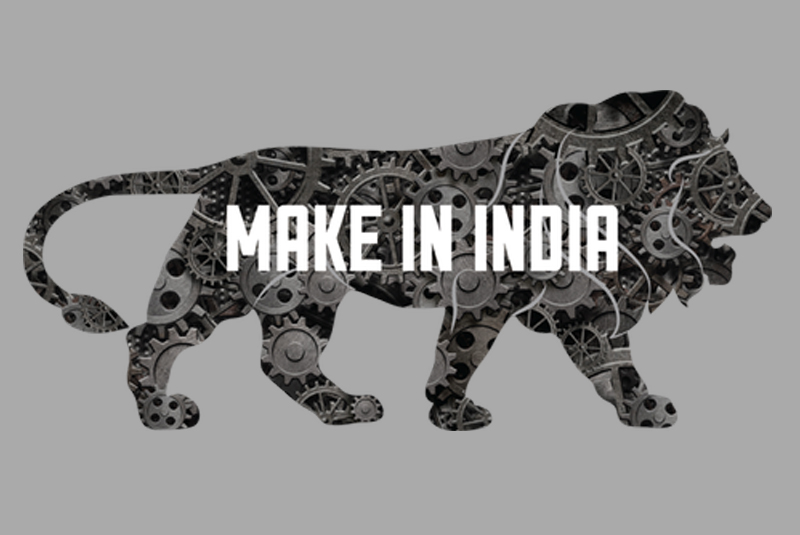On September 24, 2014, amidst customary fanfare and sloganeering, Narendra Modi, the Prime Minister of India, signed an ambitious ‘Make in India’ programme, ostensibly to transform India into a global manufacturing hub. It had three major objectives.
- First: to catapult the Indian manufacturing sector to 25 per cent of GDP from 16.4 per cent by 2022 (revised to 2025).
- Second: to register and sustain 12-14 per cent year-on-year (YOY) growth
- Third: to create an additional 100 million jobs by 2022.
The ‘Make in India’ programme is now in its tenth year. However, none of its goals have materialised. The incumbent NDA government, which thrives on its gargantuan PR machinery and event management, is uncharacteristically silent on its dismal outcomes.
Make In India statistics paint a disquieting picture. The manufacturing sector in India has declined. The manufacturing growth rate has averaged around 5.9 per cent since 2014, lower than the benchmarked 12-14 per cent, and the share of manufacturing remained stagnant at 16.4 per cent of the GDP.
The labour force representation in the manufacturing sector decreased from 12.6 per cent in 2011-’12 to 11.6 per cent in 2021-2022. The Index of Industrial Production (IIP) data, which tracks growth in multiple industry groups within the Indian economy, indicates a modest 2.9 per cent cumulative growth, in the manufacturing sector from years 2013-’14 through 2022- ’23.
A sector-wise breakup of growth within the manufacturing industry represents a bleak outlook; growth in electrical equipment manufacturing averaged (-)1.8 per cent since 2013-’14, and computer, electronics, and optical products growth stagnated at 2 per cent. The transport equipment industry registered a paltry 2.3 per cent growth, and so did motor vehicles at 1.6 per cent. Conventional employment-generating sectors of textile, apparel and leather industries underperformed (-) 0.5 per cent, 1.2 per cent and (-) 1.8 per cent, respectively. To put things into perspective, the number of cars sold in 2020 was the same as in 2012.
Contrary to the hyperbolic declaration of creating 100 million jobs in the manufacturing sector by 2022, India ruefully lost 24 million jobs between 2017 and 2021. The COVID-19 pandemic and the government’s response to a stringent curfew-like lockdown aggravated the manufacturing sector’s woes.
Even before the draconian lockdown and closure of economic activity, 11 million manufacturing jobs were already lost before the pandemic ravaged the nation. This was primarily due to a “twin-balance sheet” problem, adversely impacting the balance sheets of corporates and banks simultaneously, replete with nonperforming assets. Corporate loans dried up, and consequently, private investments as a percentage of GDP – a key engine of economic growth- fell substantially.
Private investments peaked at 27.5 per cent of GDP in 2007-’08 since the economic liberalisation of 1991. Even post-Great Recession of 2008, private investments were resilient and sustained at 27 per cent in 2011-’12. But the steep decline started in 2015-’16 when it fell to 21.3 per cent, and by 2020-’21 – based on the last Economic Survey disaggregation of data for public and private investments – private investments as a percentage of GDP had plummeted to 19.6 per cent.
Corporate investments are a factor of four critical variables: profitability, capacity utilisation, consumer demand and availability of credit. Capacity utilisation fluctuated between 60-70 per cent in the last decade, which is grossly inadequate for manufacturing companies to commit to new capex cycles. Companies invest in new plants and machinery and upgrade existing ones when capacity touches around 90 per cent, substantiated by buoyant demand.
Consumer demand, especially rural household consumption, has witnessed a downward trend due to unemployability, falling incomes and subsequent demand depression. This is exacerbated by high inflation, a deterrent for private investments in the economy since monetary policy corrections to subvert inflation always raise the cost of capital.
Despite the finance ministry slashing corporate taxes for resident companies to 25 per cent in the 2019-20 budget and to promote entrepreneurial spirit in the country, corporate taxes for new businesses at only a meagre 15 per cent. Yet, these supply-side incentives could not persuade Indian corporates and entrepreneurs to galvanise new investments and spur economic growth. In 2019, 12.5 million people applied for 35,000 railway jobs, a testimony to the distress prevalent in the job market.
In the last few years, the share of the labour force in agriculture has increased due to the dearth of urban and semi-urban employment opportunities. An Azim Premji University Report, ‘State of Working India 2023,‘ revealed that 42 per cent of graduates under the age of 25 are currently unemployed. A recent Periodic Labor Force Survey (PLFS) revealed that 58 per cent of the workforce (95 million) are self-employed, which, contrary to SBI economists’ citing robust entrepreneurial activity and structural transformation in the labour force are distress employment – forced to become a peddler on street pavements for lack of regular paid employment – according to economist and former Chief Statistician of India, Pronob Sen.
India’s unemployment woes positively correlate with a decline in the MSME (Micro, Small, Medium Enterprises) sector, touted as the backbone of the economy, bulwark of job generation and export-led growth. Since fiscal year 2020-’21, MSME exports have steadily deteriorated, from 49.4 per cent to 43.6 per cent in 2022-’23. These reductions are substantial and have translated into widespread unemployment, especially in the rural areas where 52 per cent of the MSMEs are located.
Global companies that have offshore manufacturing facilities in China are envisaging a China Plus One strategy, as the Chinese labour force concentrated on the coastal hubs has become uncompetitive due to rising wages and income levelling. Also, China, a single-party authoritarian state, has recently embarked on punitive actions against private companies, providing impetus for MNCs to look for alternatives.
As a result of these macroeconomic and sociopolitical developments, China had to relinquish $150 billion worth of market share in labour-intensive goods. India was able to capture only 10 per cent of that lost value, with the majority going to other East Asian countries like Vietnam, the Philippines, Indonesia and also Bangladesh. With a population of 100 million, Vietnam now exports the equivalent value in US dollars to India, which is 1.4 billion.
India’s response to the emerging global opportunity left by China was to launch the Atmanirbhar Bharat Abhiyaan (self-reliant India) scheme, an inward-looking and protectionist framework, allegedly benefitting only a few Indian conglomerates. In hindsight, it is only an iteration of the regressive “License Raj” regime, the erstwhile Indian economic policy, before the liberalisation of 1991.
The Atmanirbhar Scheme is characterised by a three-pronged strategy. Raising tariffs for imported goods, providing subsidies through a Production Linked Incentive (PLI) scheme, and promoting ‘national champions’ are the three vaunted elements of this industrial policy. Since 2014, India has raised tariffs for more than 3200 goods, adversely impacting 70 per cent of imports.
India is mainly a re-exporter that relies heavily on imports of intermediate goods, which are further processed to add value to the value chain and subsequently exported. High tariffs have hurt domestic manufacturers of export-oriented goods’ global competitiveness. It also serves as a deterrent for FDI flows and dissuades global companies from engaging in Greenfield investments and Brownfield acquisitions in India.
Between 2014 and 2021, more than 2700 MNC’s have closed operations in India. Prominent among them are GM, Ford, Harley Davidson, Cairn Energy, Hutchinson, Docomo, Lafarge, Carrefour, Henkel, Daiichi Sanyo, Man Truck and Bus, Holcim, etc., citing unsustainable policy framework, price wars and declining profitability. License Raj in India has resurged as equally deleterious ‘Resource Raj’ and ‘Subsidy Raj’, denting investor confidence.
The incumbent government is patronising and promoting two giant conglomerates, Adani Group and Mukesh Ambani-led Reliance Industries, to create ‘national champions’ for supporting policy goals. This has precedence in Zaibatsu in Japan and Chaebols of South Korea, where governments handpicked business houses to transform them into conglomerates as part of their industrial policies. In Japan and South Korea, such initiatives were meticulously planned and guided under stringent caveats, which were mandatory to design and develop globally competitive products and brands.
But in India, Adani and Ambani are favoured for their deep presence in non-tradeable domestic infrastructure sectors, sold within India, insulated from global competition through government regulations in tariffs and subsidies. Though the rollout of broadband, 4G network by Reliance Jio has been a success story, providing millions of Indians access to the internet, the drawbacks of creating national champions far outweigh the intended benefits.
Telecommunications providers Bharti Airtel and Vodafone were crippled financially due to nepotism, which irredeemably impaired their strategic vision of upgrading the cellular network to 5G speeds. Similarly, an abrupt change in e-commerce regulations impeded the Tata Group, Walmart, and Amazon from developing their online retail platforms. Failure to create a level playing field through detrimental policies, including formalisation and import substitution, would only stifle innovation, efficiency, competition, and economic growth. Because of the scope and reach of Adani and Ambani in the economy, they will become too big to fail, which could potentially cause collateral damage.
Make in India’s much-touted success story is technology behemoth Apple assembling iPhones in India. Eminent economist and India’s former Reserve Bank governor, Dr Raghuram Rajan, laid out the unit economics and cost-benefit analysis of wooing Apple to India.
iPhone assembly represents the value chain’s lowest rung, constituting 4 per cent of the cost structure. India is offering 6 per cent of the invoice price as a subsidy under the production-linked incentive (PLI) scheme, euphemistically bribing a cash-rich tech giant to establish operations in India. Therefore, the associated wages for the cost of assembly are paid by the taxpayers’ money.
If Indian manufacturing aspires to move up the value chain, performing advanced manufacturing or sub-assembly operations that are significant revenue generators, there will be intense competition from China, Taiwan, and Vietnam as they still exist. The PLI scheme mainly targets capital-intensive industries that have longer gestation periods for ROI. The need of the hour to ameliorate India’s gnawing unemployment crisis is to incentivise the establishment and development of export-oriented, labour-intensive businesses.
Another injudicious move was India opting out of the Regional Comprehensive Economic Partnership (RCEP), a regional trade agreement between vibrant and dynamic economies in the Asia-Pacific, covering one-third of the global population and 30 per cent of the global GDP output. The signatories include China, Japan, New Zealand, Australia, South Korea, Singapore and other ASEAN countries, which would have given a tremendous fillip for Indian manufacturing exports through automatic access to the world’s largest market and trading bloc.
Yet, the long-term strategy warrants India’s lynchpin role in the global services economy, capitalising on the vast whirlpool of talent, English-speaking managers, and entrepreneurial acumen of digital start-ups. The service sector currently contributes more than 50 per cent of GDP growth at current prices. The global diaspora of Indian managers, adorning stellar roles in the services sector in most developed G7 countries, could play a vital role in this Indian renaissance.
With the impressive corpus of intellectual capital available, Indians should be designing a smartphone, competing with an iPhone, receiving royalties from IP assets, and earning staggering topline revenues from marketing and finance. These activities are high-up on the value chain. Foxconn, which manufactures Apple iPhones, has a market valuation of $45 billion. Apple Inc., which designs its flagship phones and does no manufacturing, is valued at around $3 trillion. It is a classic case of the imperative of moving up the value chain. Massive investments in tertiary education, the proliferation of world-class universities, the establishment of sophisticated R&D facilities, and the conducting of cutting-edge fundamental research are therefore inevitable.
The last ten years have witnessed substantial investments in physical infrastructure in roads, ports, highways, and railways, which are commendable initiatives in improving the base economy. Also, the rise of the “DigiTech”, financial inclusions, Unified Payment Interface (UPI) for streamlining digital payments and facilitating an explosion of e-commerce, a redistributive development model subsidising private goods for public consumption – in building toilets, distributing cooking gas, electricity, housing, and direct benefit cash transfers – have indeed enhanced the quality of life of millions of poor and disadvantaged beneficiaries in the lower economic strata.
But growth should be prioritised. The Indian manufacturing sector, historically plagued by disabilities in poor infrastructure, exorbitant logistics and transportation costs, a dearth of quality, and high-skilled labour, requires contingency-level planning and redemptive action. Human capital development should be emphasised by physical capital. The Atmanirbhar scheme should be abolished to create an egalitarian development model. If India wants to become a global manufacturing hub, the Make in India program must be synergised with an Invent in India vision.
-30-
Copyright©Madras Courier, All Rights Reserved. You may share using our article tools. Please don't cut articles from madrascourier.com and redistribute by email, post to the web, mobile phone or social media.Please send in your feed back and comments to [email protected]











